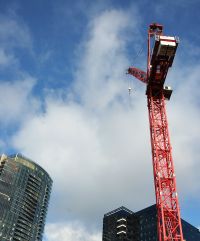Published February 27 2013
Remember the "crane index"?
It was an informal gauge of development activity -- and economic health -- in downtown Bellevue. The index consisted of the number of tower cranes hovering above large construction sites across the city. After a recession-fueled absence, the cranes may be coming back.
The possible return of large-scale, commercial developments downtown soon is covered in this month's edition of It's Your City, the resident newsletter. Other stories in the issue address:
- the continuing public process related to the East Link project;
- planned construction of a new visitor center at the Bellevue Botanical Garden and a new Bellevue Youth Theatre; and
- a column from Councilmember Kevin Wallace celebrating efforts to help neighbors in need.
At the newsletter page you can see flipbook versions of many issues and sign up for email or text Alerts whenever a new issue is posted.
Big projects in the wings?
The crane tally topped out at 21 in 2007, at the height of the last development cycle. Most everyone knows what happened after that: a major recession followed by a slow recovery. For a long time there were no tower cranes downtown.
But the crane index may be ready to rise again. Currently there is one big crane downtown, for the first phase of the Soma Towers project at Northeast Second Street and 106th Avenue Northeast.
Other crane-worthy projects could be in the wings, according to Mike Brennan, director of Bellevue's Development Services Department. He said Bellevue is seeing early permitting for some work downtown, and interest clearly is growing for big developments around the city.
City Manager Steve Sarkozy agrees. "I'm hearing from developers who say they're ready to pull the trigger on some major projects, and I'm hearing from folks on the other end -- tenants -- who are primed for those projects. So I do think we're getting close, especially downtown."
Another area expected to be part of the next development cycle, said Brennan, is the 900-acre Bel-Red corridor, northeast of downtown. It will create new opportunities for higher-density development that will be connected to downtown Bellevue and Seattle by the future East Link light rail line.
"There are more conversations, especially about downtown projects, and that's a prelude to the formal development process," Brennan said. "The question for us is not so much whether big projects will get rolling, but when, how big and how fast the development will come."
Based on one set of numbers from 2012, it appears the development cycle may have turned already. The value of major projects in 2012, based on permits issued, more than quadrupled compared with 2011, rising from $46 million to $194 million. And, the total valuation (including major projects, new residential projects, commercial and residential remodels) citywide more than doubled, from $168 million in 2011 to $375 million in 2012.
Brennan expects the next expansion to look different than the previous one. He described the last development cycle, which started to ramp up in 2005, peaked in 2007, and bottomed out in 2011 (tracked by total valuation based on permits issued), as relatively short, but dramatic.
"It was exciting, but at times overwhelming to the community to deal with growth that fast," Brennan said. "I expect the next cycle will be more moderate than the last cycle."
The steep development slowdown forced the City Council to cut Development Services' budget by $4.2 million and eliminate 30 staff positions from 2010 to 2012. Now, as construction increases, the department will add staff to keep pace with development activity.
Like the last development cycle, current signs point toward a range of big downtown projects, including residential (mostly apartments), hotels and office buildings.
Big projects in various stages of the development pipeline currently include the Lincoln Square Expansion, a large office-hotel-condominium-retail complex that will mirror the original Lincoln Square property nearby; a new 376-room Marriott Hotel; and a new office tower planned on Northeast Eighth Street, expected to be among the largest in the city.
"I have a high level of confidence we'll see significant investment in a wide range of project types," Brennan said. "It's difficult to predict exactly what the next cycle will look like, but I do know that when the financial commitments return, so will the cranes."

